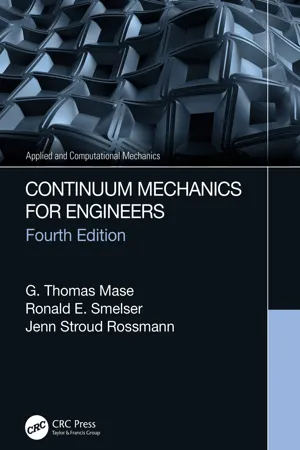1.1Chapter Learning Outcomes
After mastering the material in this chapter, you will be able to:
•Appreciate the continuum assumption and concepts
•Distinguish between fundamental and constitutive equations
•Contextualize the continuum framework and notation
The atomic/molecular composition of matter is well established. On a small enough scale, a body of aluminum is really a collection of discrete aluminum atoms stacked on one another in a particular repetitive lattice. And on an even smaller scale, the atoms consist of a core of protons and neutrons around which electrons orbit. Thus matter is not continuous. At the same time, the physical space in which we live is truly a continuum, for mathematics teaches us that between any two points in space we can always find another point regardless of how close together we choose the original pair. Clearly then, although we may speak of a material body as “occupying” a region of physical space, it is evident that the body does not totally “fill” the space it occupies. It is this “occupying” of space that will be the basis of our study of continuum mechanics.
1.2Continuum Mechanics
If we accept the continuum concept of matter, we agree to ignore (or more precisely, to average) the discrete composition of material bodies, and to assume that the substance of such bodies is distributed uniformly throughout, and completely fills the space it occupies. In keeping with this continuum model, we assert that matter may be divided indefinitely into smaller and smaller portions, each of which retains all of the physical properties of the parent body. Accordingly, we are able to ascribe field quantities such as density and velocity to each and every point of the region of space which the body occupies.
The continuum model for material bodies is important to engineers for two very good reasons. On the scale by which we consider bodies of steel, aluminum, concrete, etc., the characteristic dimensions are extremely large compared to molecular distances, so that the continuum model provides a very useful and reliable representation. Additionally, our knowledge of the mechanical behavior of materials is based almost entirely upon experimental data gathered by tests on relatively large specimens.
The analysis of the kinematic and mechanical behavior of materials modeled on the continuum assumption is what we know as Continuum Mechanics. There are two main themes into which the topics of continuum mechanics are divided. In the first, emphasis is on the derivation of fundamental equations which are valid for all continuous media. These equations are based upon universal laws of physics such as the conservation of mass, the principles of energy and momentum, etc. In the second, the focus of attention is on the development of the constitutive equations characterizing the behavior of specific idealized materials; the perfectly elastic solid and the viscous fluid being the best known examples. These equations provide the focal points around which studies in elasticity, plasticity, viscoelasticity and fluid mechanics proceed.
Mathematically, the fundamental equations of continuum mechanics mentioned above may be developed in two separate but essentially equivalent formulations. One, the integral, or global form, derives from a consideration of the basic principles being applied to a finite volume of the material. The other, a differential, or field approach, leads to equations resulting from the basic principles being applied to a very small (infinitesimal) element of volume. In practice, it is often useful and convenient to deduce the field equations from their global counterparts.
As a result of the continuum assumption, field quantities such as density and velocity which reflect the mechanical or kinematic properties of continuum bodies are expressed mathematically as continuous functions, or at least piecewise continuous functions, of the space and time variables. Moreover, such functions are sufficiently smooth that their derivatives will be continuous as well.
Inasmuch as this is an introductory textbook, we shall make two further assumptions on the materials we discuss in addition to the principal one of continuity. First, we require the materials to be homogeneous, that is to have identical properties at all locations. And secondly, that the materials be isotropic with respect to certain mechanical properties, meaning that those properties are the same in all directions at a given point. Later, we will relax this isotropy restriction to discuss briefly anisotropic materials which have important meaning in the study of composite materials.
1.3Starting Over
The topic of continuum mechanics typically comes at the end of an undergraduate or at the beginning of a graduate program. Continuum mechanics has a reputation of being a theoretical course more focused on mathematical abstraction than on applications. The first part of continuum mechanics’ reputation is correct: it is based on fundamental mathematics and mechanics. However, the second part is not founded. There are many, many applications for continuum mechanics, but it is hard to cover the basics and develop the applications in a single quarter or semester. Continuum mechanics takes all the mathematical, physical and engineering principles and casts them in a single structure from which the student is prepared to pursue advanced engineering topics. After a course in continuum mechanics many applications become accessible to the student: elasticity, nonlinear elasticity, plasticity, crashworthiness, biomechanics, polymers and more. Many sophisticated simulation programs such as LS-DYNA® become a playground for advanced design and analysis once continuum mechanics has been mastered.
Some students find continuum mechanics to be a difficult subject. However, outside of a new notation, the topics studied should be very familiar to the student. Vectors have to be written in component form, and we need to be able to use “dot” and “cross” products. These are skills from the sophomore level statics course. Also needed will be a description for conservation of linear and angular momentum. Taking the time rate of change of these quantities is really no different from what was done in an...
